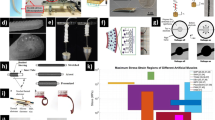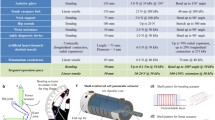Abstract
Soft robotic structures might play a major role in the 4th industrial revolution. Researchers have demonstrated advantages of soft robotics over traditional robots made of rigid links and joints in several application areas including manufacturing, healthcare, and surgical interventions. However, soft robots have limited ability to exert larger forces and change their stiffness on demand over a wide range. Stiffness can be achieved as a result of the equilibrium of an active and a passive reaction force or of two active forces antagonistically collaborating. This paper presents a novel design paradigm for a fabric-based Variable Stiffness System including potential applications.
Access this chapter
Tax calculation will be finalised at checkout
Purchases are for personal use only
Similar content being viewed by others
References
Arezzo, A., Mintz, Y., Allaix, M. E., Arolfo, S., Bonino, M., Gerboni, G., et al. (2016). Total mesorectal excision using a soft and flexible robotic arm: A feasibility study in cadaver models. Surgical Endoscopy, 31(1), 264273.
Bauer, S., Bauer-Gogonea, S., Graz, I., Kaltenbrunner, M., Keplinger, C., & Schwoediauer, R. (2014). 25th anniversary article: A soft future: From robots and sensor skin to energy harvesters. Advanced Materials, 26(1), 149162.
Burgner-Kahrs, J., Rucker, D. C., & Choset, H. (2015). Continuum robots for medical applications: A survey. IEEE Transactions on Robotics, 31(6), 1261–1280.
Cianchetti, M., Arienti, A., Follador, M., Mazzolai, B., Dario, P., & Laschi, C. (2011). Design concept and validation of a robotic arm inspired by the octopus. Materials Science and Engineering C, 31, 1230–1239.
Crespi, A., Badertscher, A., Guignard, A., & Ijspeert, A. J. (2005). AmphiBot I: An amphibious snake-like robot. Robotics and Autonomous Systems, 50(4), 163–175.
Faragasso, A., Stilli, A., Bimbo, J., Noh, Y., Liu, H., et al. (2014). Endoscopic add-on stiffness probe for real-time soft surface characterisation in MIS. In: International Conference of the IEEE Engineering in Medicine and Biology Society (pp. 6517–6520).
Hawkes, E. W., Blumenschein, L. H., Greer, J. D., & Okamura, A. M. (2017). A soft robot that navigates its environment through growth. Science Robotics, 2(8).
Horvath, M. A., Wamala, I., Rytkin, E., Doyle, E., Payne, C. J., Thalhofer, T., et al. (2017). An intracardiac soft robotic device for augmentation of blood ejection from the failing right ventricle. Annals of Biomedical Engineering, 45(9), 2222–2233.
Kamegawa, T., Yarnasaki, T., Igarashi, H., & Matsuno, F. (2004). Development of the snake-like rescue robot kohga. In IEEE International Conference on Robotics and Automation (pp. 5081–5086).
Lipson, H. (2014). Challenges and opportunities for design, simulation, and fabrication of soft robots. Soft Robotics, 1(1), 21–27.
Maghooa, F., Stilli, A., Noh, Y., Althoefer, K., & Wurdemann, H. A. (2015). Tendon and pressure actuation for a bio-inspired manipulator based on an antagonistic principle. In IEEE International Conference on Robotics and Automation (pp. 2556–2561).
Manti, M., Cacucciolo, V., & Cianchetti, M. (2016). Stiffening in soft robotics: A review of the state of the art. IEEE Robotics and Automation Magazine, 23(3), 93–106.
Pfeifer, R., Marques, H. G., & Iida, F. (2013). Soft robotics: The next generation of intelligent machines. In International Joint Conference on Artificial Intelligence (pp. 5–11).
Robinson, G., & Davies, J. B. C. (1999). Continuum robots—A state of the art. In IEEE International Conference on Robotics and Automation (p. 4).
Rossiter, J., & Hauser, H. (2016). Soft robotics the next industrial revolution. IEEE Robotics and Automation Magazine, 23, 17–20.
Sareh, S., Jiang, A., Faragasso, A., Nanayakkara, T., Dasgupta, P., Seneviratne, L., Wurdemann, H., et al. (2014). MR-compatible bio-inspired tactile sensor sleeve for surgical soft manipulators. In IEEE International Conference on Robotics and Automation (pp. 1454–1459).
Shiva, A., Stilli, A., Noh, Y., Faragasso, A., Althoefer, K., & Wurdemann, H. A. (2016). Tendon-based stiffening for a pneumatically actuated soft manipulator. IEEE Robotics and Automation Letters, 1(2), 632–637.
Stilli, A., Wurdemann, H. A., & Althoefer, K. (2014). Shrinkable, stiffness-controllable soft manipulator based on a bio-inspired antagonistic actuation principle. In IEEE International Conference on Robotics and Automation (pp. 2476–2481).
Stilli, A., Wurdemann, H. A., & Althoefer, K. (2016). A novel concept for safe. Stiffness-Controllable Robot Links, Soft Robot, 4(1), 16–22.
Stilli, A., Grattarola, L., Feldmann, H., Wurdemann, H. A., & Althoefer, K. (2017). Variable Stiffness Links VSL—Toward inherently safe robotic manipulators. In IEEE International Conference on Robotics and Automation (pp. 4971–4976).
Wurdemann, H. A., Sareh, S., Shafti, A., Noh, Y., Faragasso, A., Chathuranga, D. S. (2015). Embedded electro-conductive yarn for shape sensing of soft robotic manipulators. In International Conference of the IEEE Engineering in Medicine and Biology Society (pp. 8026–8029).
Wurdemann, H., Stilli, A., & Althoefer, K. (2015). Lecture notes in computer science: An antagonistic actuation technique for simultaneous stiffness and position control. In International Conference on Intelligent Robotics and Applications (pp. 164–174).
Author information
Authors and Affiliations
Corresponding author
Editor information
Editors and Affiliations
Rights and permissions
Copyright information
© 2018 Springer Nature Switzerland AG
About this chapter
Cite this chapter
Stilli, A., Althoefer, K., Wurdemann, H.A. (2018). Soft Robotics. Bio-inspired Antagonistic Stiffening. In: Karafillidis, A., Weidner, R. (eds) Developing Support Technologies. Biosystems & Biorobotics, vol 23. Springer, Cham. https://doi.org/10.1007/978-3-030-01836-8_20
Download citation
DOI: https://doi.org/10.1007/978-3-030-01836-8_20
Published:
Publisher Name: Springer, Cham
Print ISBN: 978-3-030-01835-1
Online ISBN: 978-3-030-01836-8
eBook Packages: Computer ScienceComputer Science (R0)




